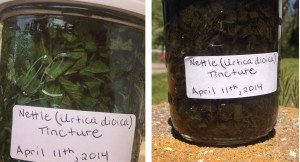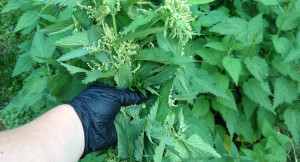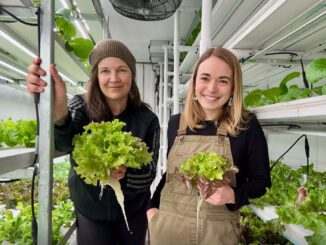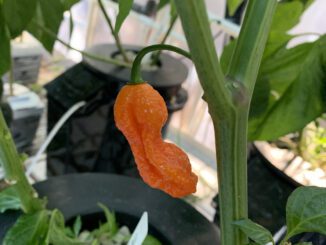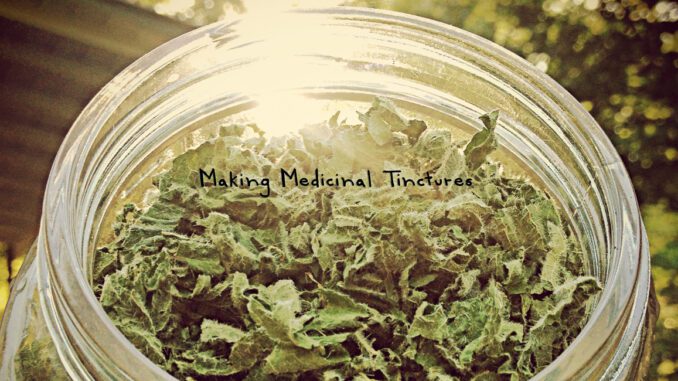
Making Medicinal Tinctures
Tincture Time!
Get Outta My Garden and Into My Jar
By Frazer Love
-From Grozine Issue 12-
Making medicinal tinctures is our topic today. Recent articles have focused on herbal curing and extraction. Today we are going to continue the conversation with making medicinal tinctures from common plants, Urtica dioica (Stinging Nettle) tinctures in particular.
Those who know this plant revere it for its seemingly endless medicinal and even plant beneficial applications. Many organic gardeners I’ve talked to incorporate nettle into their gardening practice in some way. It is integral as part of their probiotic teas/brews. To understand why Nettle is so well respected in making medicinal tinctures we must first understand its origins and biologic profile.
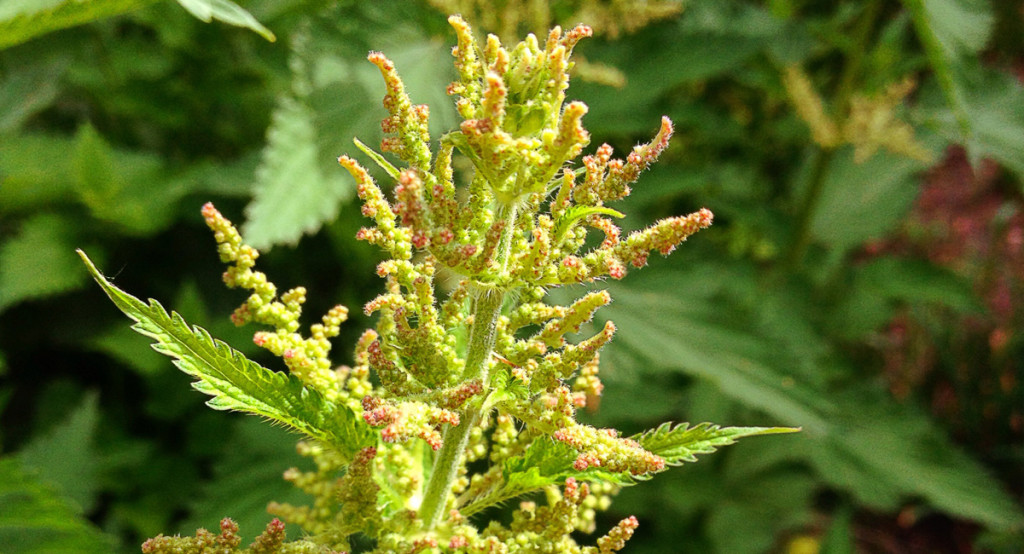
I first started growing nettle last year after buying some seeds from Baker Creek Heirloom Seed Co. I’d heard about all the good things it can do for both body and garden, so I went for it.
Although, it wasn’t until recently that I began to seriously look into its various preparations and benefits with regards to making medicinal tinctures. Much of the beginning of my knowledge came, as one might expect in a digital age, from my social media friends. As with most theory, though, it’s just that, until you find someone within driving distance to help you apply these theories. It was an old friend, Virginia Nellans, who actually took my ideas and made something of them.
Virginia has studied Ethnobotany, or the scientific study of the relationship between people and plants. She has taken this knowledge and applied it liberally to creating natural remedies such as salves, ointments, decoctions, capsules, tinctures, infused cooking oils, and even herb infused whiskey.
This passion wouldn’t have come about had she not changed direction from primate studies to ethnobotany, a last minute decision. Luckily, for me and you as a reader, we are able to benefit from the nettle knowledge bomb she’s dropped.
“Nettle has been the center of herbal medicine for centuries. It has several proven benefits including anti-inflammatory action, anti-irritant, anti-asthmatic, adrenal supporting properties, and when taken for 30 days or more, Nettle can help control allergic reactions.
Nettle is a general body tonic, and a nutrient dense herb. It contains a significant amount of plant protein (25%), chlorophyll, vitamins A, C, and D, and minerals iron, calcium, potassium, and manganese.
The calcium content makes it a wonderful herb for easing leg cramps and muscle spasms. Nettle is one of the highest sources of plant-digestible iron and can be used to treat mild anemia.
Nettle’s most popular use is as a cleansing and detoxifying herb. It’s a natural diuretic and aids in the body’s elimination of waste products. It can also be used topically for many skin conditions and to stop bleeding.”
Nettle Facts:
-grows in temperate regions around the world as a perennial.
-aerial parts of the plant are picked in the summer before the plant blooms.
has the flavor of spinach, and has replaced it in many cultures due to its relative hardiness.
in bloom the plant produces cystoliths, which can irritate the urinary tract.
-the plant also becomes bitter like most greens when they bolt.
-in fall the roots and rhizomes can be harvested and dried for teas which have been proven effective in scientific trials in both Germany and Japan as a treatment for benign prostatic hyperplasia (BPH).
Recent studies done in Europe (http://www.arthritisresearchuk.org/arthritis-information/complementary-and-alternative-medicines/cam-report/complementary-medicines-for-osteoarthritis/stinging-nettle/trials-for-oa.aspx) have shown the active constituents of nettle leaf have significant anti-inflammatory properties.
Battling with Arthritis?
Click HERE for More
Nettle’s key constituents include:
-
Aerial Parts
- Flavanoids (quercitin)
- Amines (histamine, choline, acetylcholine, serotonin)
- Glucoquinone
- Mineral (calcium, potassium, silicic acid, iron)
-
Root
- Plant sterols (stigmast-4-enzone and stigmasterol)
- Phenols
-
Key Actions
- Diuretic
- Tonic
- Astringent
- Prevents hemorrhaging
- Antiallergenic
- Reduces prostate enlargement (root)
- Anti-inflammatory
Most recently, Virginia created a nettle tincture from a large bouquet of nettle stalks I plucked from my little experimental permaculture plot. The tincture is one of the best ways of preserving all of the volatile medicinal compounds held within the fresh nettle. She mentions that fresh is usually better than dried when extracting medicinal compounds from herbs. The reactive nature of phenolic acids and aromatic hydrocarbons makes fresh extractions critical.
However, this does not always hold true. There are some plants that are toxic when not dried or cured properly.
I suggest reading Andrew Chevallier’s text, Encyclopedia of Herbal Medicine, in order to better recognize and understand a wide range of medicinal plants. Making a tincture requires soaking the herb in alcohol (vodka, rum, whiskey).
Alcohol and oil dissolve evenly into each other due to them being miscible, as well as, having a similar molecular make-up. This makes tinctures fairly strait forward and simple. The tincture has a stable shelf life of up to 2 years!
- Tinctures are strong preparations, and it is essential to check the recommended dosage. Never use industrial alcohol, methylated spirits (methyl alcohol), or rubbing alcohol (isopropyl alcohol) in tinctures.
- Alcoholic tinctures should be avoided during pregnancy and/or gastric inflammation.
- Adding 5 ml of tincture to a small glass of almost boiling water and leaving for 5 minutes allows the alcohol to evaporate.
- To make nonalcoholic tinctures, replace alcohol with vinegar or glycerol.
- Standard tincture ratio is 1:5 at 1 part herb to 5 parts alcohol
When making medicinal tinctures you’ll need the following items:
- Pesticide/Fungicide free herb of choice (Nettle in this case) 1 part
- Tincture specific alcohol of choice 5 parts
- Large glass jar with lid
- Small label w/ date and contents written
- Small wine press or nylon/cheese cloth for straining plant matter
- Funnel
- Dark colored glass (preferably UV proof/Violiv jars from a Bloomington Wholesale distributor like Flora Hydroponics)
- And 2 to 6 weeks of patience
1. place the plant matter into the glass jar.
2. pour in the alcohol making sure it covers all the herbs.
3. make sure to shake the bottle up to ensure everything is mixed thoroughly.
4. store in a cool dark place for the next two to six weeks;
5. the longer the soak the stronger the brew.
Over time the tincture will begin to darken as the oils and alcohols dissolve into one another, infusing your tincture with the awesome healing power of medicinal herbs.
Once the herbs have soaked for several weeks it’s time to drain and press the mash for making medicinal tinctures. If you’ve got a small wine press, then this is a bit easier. If not, cheesecloth will work fine or even a mesh strainer. After straining out the mash, carefully transfer the tincture into clean dark glass.
With this final product you have a highly concentrated form of the complete medicinal profile of your selected herb. With a tincture you only need a dropper full in a cup of water or tea to get the full benefits of the plant. So, as you can see a quart or even a pint could last you a long time.
If you are looking for a source of organic medicinal herbs, Virginia recommends Mountain Rose Herbs (https://www.mountainroseherbs.com/). This company is known for practicing what it preaches through sustainable growing methods and integrated communal action. They have a sister company, HerbMentor (https://www.HerbMentor.com/) that hosts forums for easy sharing and learning, provides guided lessons, and exclusive content on Herbalism.
Both come highly recommended from my extract queen, Virginia. I’d like to personally thank Virginia for helping me gather all this information into one helpful article.
Her dedication to her craft is inspirational. Hopefully, it will inspire some of you to grow and extract your own medicine.
About the Author:
Frazer Love knew his life was etched in stone after…
meeting a fellow UGA student, fully involved in a double major in horticulture and business management. The next step was taking his passion to the next level by packing his college apartment with hydro equipment and mushroom cultivation projects. These home projects turned into a desire to make this his life’s work. Since 2005, Frazer has worked with various hydroponics shops (Atlantis Hydro & Flora Hydro) where he served and serves respectively as the branch manager.
As if working fulltime at a hydro shop wasn’t enough, he started his own CSA. He built Perpetual Harvest from the ground up, literally. This tiny sub-acre urban farm has given Frazer the gift of feeding the stomach and brains of his family and friends. “Through my work and writing I look to inspire others in the hopes that gardening brings them as much peace as it has brought me”

